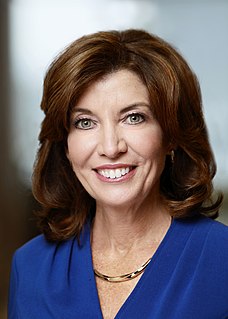History
The Prohibition state convention met on June 14 and 15 at Oswego, New York. Henry W. Wilbur was Temporary Chairman until the choice of Alfred L. Manierre as Permanent Chairman. [1] They nominated John McKee, of Brooklyn, for Governor; Alden W. Young for Lieutenant Governor; James C. Carpenter, of New York City, for Secretary of State; Ira W. Littlefield, of Watertown, for Comptroller; C. A. Shipplebein, of Glens Falls, for Treasurer; and George E. Hillman, of Rochester, for Attorney General. [2]
The Prohibition Party (PRO) is a political party in the United States best known for its historic opposition to the sale or consumption of alcoholic beverages. It is the oldest existing third party in the US. The party is an integral part of the temperance movement. While never one of the leading parties in the United States, it was once an important force in the Third Party System during the late 19th and early 20th centuries. It declined dramatically after the repeal of Prohibition in 1933. The party's candidate received 518 votes in the 2012 presidential election and 5,617 votes in the 2016 presidential election. The platform of the party is liberal in that it supports environmental stewardship, women's rights and free education, but is conservative on social issues, such as supporting temperance and advocating for a pro-life stance.

Oswego is a city in Oswego County, New York, United States. The population was 18,142 at the 2010 census. Oswego is located on Lake Ontario in north-central New York and promotes itself as "The Port City of Central New York". It is the county seat of Oswego County.

Brooklyn is the most populous borough of New York City, with an estimated 2,648,771 residents in 2017. Named after the Dutch village of Breukelen, it borders the borough of Queens at the western end of Long Island. Brooklyn has several bridge and tunnel connections to the borough of Manhattan across the East River, and the Verrazzano-Narrows Bridge connects it with Staten Island. Since 1896, Brooklyn has been coterminous with Kings County, the most populous county in the U.S. state of New York and the second-most densely populated county in the United States, after New York County.
The Socialist Labor state convention met on July 7 at 2, New Reade Street in Manhattan. They nominated Daniel De Leon for Governor; Boris Reinstein, of Buffalo, for Lieutenant Governor; Anton Metzler for Secretary of State; James A. Trainor, of Syracuse, for Comptroller; Harvey A. Santee, of New York City, for Treasurer; Frank E. Passanno for Attorney General; and Orcus A. Curtis, of Buffalo, for the Court of Appeals. [3]

The Socialist Labor Party (SLP) is the oldest socialist political party in the United States, established in 1876. It is the second oldest socialist party in the world still in existence.

Manhattan, often referred to locally as the City, is the most densely populated of the five boroughs of New York City and its economic and administrative center, cultural identifier, and historical birthplace. The borough is coextensive with New York County, one of the original counties of the U.S. state of New York. The borough consists mostly of Manhattan Island, bounded by the Hudson, East, and Harlem rivers; several small adjacent islands; and Marble Hill, a small neighborhood now on the U.S. mainland, physically connected to the Bronx and separated from the rest of Manhattan by the Harlem River. Manhattan Island is divided into three informally bounded components, each aligned with the borough's long axis: Lower, Midtown, and Upper Manhattan.

Buffalo is the second largest city in the U.S. state of New York and the largest city in Western New York. As of 2017, the population was 258,612. The city is the county seat of Erie County and a major gateway for commerce and travel across the Canada–United States border, forming part of the bi-national Buffalo Niagara Region.
The 1904 Democratic National Convention nominated the Chief Judge of the New York Court of Appeals Alton B. Parker for U.S. President. Upon accepting the nomination, he resigned his judicial office on August 5, and a month later Democrat Edgar M. Cullen was appointed by Republican Governor Benjamin B. Odell, Jr., to fill the vacancy, as part of a cross endorsement deal to elect also Republican associate judge William E. Werner.

The 1904 Democratic National Convention was an American presidential nominating convention that ran from July 6 through 10 in the Coliseum of the St. Louis Exposition and Music Hall in St. Louis, Missouri. Breaking with eight years of control by the Democratic Party's reform wing, the convention nominated conservative Judge Alton B. Parker of New York for President and Henry G. Davis of West Virginia for Vice President.

Alton Brooks Parker was an American judge, best known as the Democrat who lost the presidential election of 1904 to incumbent Theodore Roosevelt in a landslide.
The Republican state convention met on September 14 and 15 at Saratoga, New York. Jacob Sloat Fassett was Temporary Chairman until the choice of George R. Malby as Permanent Chairman. The convention was marked by the fight between the two Republican bosses: Governor Odell and Thomas C. Platt. Odell's candidate, the incumbent Lieutenant Governor Higgins, was nominated by acclamation after Platt's man, Ex-Lieutenant Governor Timothy L. Woodruff, withdrew. All other candidates were also nominated by acclamation. [4]

Saratoga is a town in Saratoga County, New York, United States. The population was 5,141 at the 2000 census. It is also the commonly used, but not official, name for the neighboring and much more populous city, Saratoga Springs. The major village in the town of Saratoga is Schuylerville which is often, but not officially, called Old Saratoga. Saratoga contains a second village named Victory.
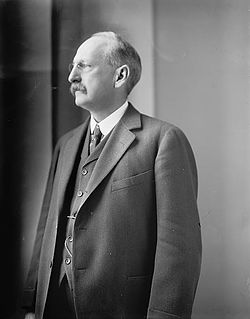
Jacob Sloat Fassett was a businessman, lawyer, and member of the United States House of Representatives from New York.

George Roland Malby was an American politician from New York. He was Speaker of the New York State Assembly in 1894, and served three terms in Congress.
On September 16, the Populist State Committee selected a ticket to be circulated to gather the necessary signatures for the petition to file the ticket. They nominated Alfred J. Boulton for Governor; Charles Spaulding, of Buffalo, for Lieutenant Governor; Orsen L. Drew, of Rochester, for Secretary of State; Louis Manz, of Rochester, for Comptroller; Frank S. Rose, of Albany, for Treasurer; John F. Gaffney, Utica, for Attorney General; Simon G. Levy, of New York City, for State Engineer; Edward N. Heath, of Buffalo, for Chief Judge; and Augustus Babcock, of Binghamton, for associate judge of the Court of Appeals. [5] The petition was filed with the Secretary of State in October. [6]

Rochester is a city on the southern shore of Lake Ontario in western New York. With a population of 208,046 residents, Rochester is the seat of Monroe County and the third most populous city in New York state, after New York City and Buffalo. The metropolitan area has a population of just over 1 million people. It is about 73 miles (117 km) east of Buffalo and 87 miles (140 km) west of Syracuse.
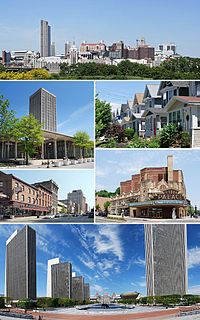
Albany is the capital of the U.S. state of New York and the seat of Albany County. Albany is located on the west bank of the Hudson River approximately 10 miles (16 km) south of its confluence with the Mohawk River and approximately 135 miles (220 km) north of New York City.

Utica is a city in the Mohawk Valley and the county seat of Oneida County, New York, United States. The tenth-most-populous city in New York, its population was 62,235 in the 2010 U.S. census. Located on the Mohawk River at the foot of the Adirondack Mountains, Utica is approximately 95 miles northwest of Albany, 55 mi (89 km) east of Syracuse and 240 miles northwest of New York City. Utica and the nearby city of Rome anchor the Utica–Rome Metropolitan Statistical Area, which comprises all of Oneida and Herkimer counties.
The Democratic state convention met on September 21 at Saratoga, New York. [7]

The 1966 New York state election was held on November 8, 1966, to elect the Governor, the Lieutenant Governor, the State Comptroller, the Attorney General and the Chief Judge of the New York Court of Appeals, as well as all members of the New York State Assembly and the New York State Senate. Besides, 15 delegates-at-large to the New York State Constitutional Convention of 1967 were elected on the state ticket, and three delegates each in the 57 senatorial districts.

The 1946 New York state election was held on November 5, 1946, to elect the Governor, the Lieutenant Governor, the State Comptroller, the Attorney General, a U.S. Senator, the Chief Judge and an associate judge of the New York Court of Appeals, as well as all members of the New York State Assembly and the New York State Senate.
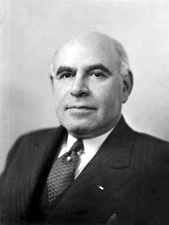
The 1934 New York state election was held on November 6, 1934, to elect the Governor, the Lieutenant Governor, the State Comptroller, the Attorney General, a U.S. Senator, two U.S. Representatives-at-large, the Chief Judge and two associate judges of the New York Court of Appeals, as well as all members of the New York State Assembly and the New York State Senate.

The 1928 New York state elections were held on November 6, 1928, to elect the Governor, the Lieutenant Governor, the State Comptroller, the Attorney General, a U.S. Senator and a judge of the New York Court of Appeals, as well as all members of the New York State Assembly and the New York State Senate.

The 1922 New York state election was held on November 7, 1922, to elect the Governor, the Lieutenant Governor, the Secretary of State, the State Comptroller, the Attorney General, the State Treasurer, the State Engineer and a U.S. Senator, as well as all members of the New York State Assembly and the New York State Senate. Besides, two amendments to the State Constitution were proposed.

The 1914 New York state election was held on November 3, 1914, to elect the Governor, the Lieutenant Governor, the Secretary of State, the State Comptroller, the Attorney General, the State Treasurer, the State Engineer, a U.S. Senator and a judge of the New York Court of Appeals, as well as all members of the New York State Assembly and the New York State Senate, and delegates-at-large to the New York State Constitutional Convention of 1915.

The 1912 New York state election was held on November 5, 1912, to elect the Governor, the Lieutenant Governor, the Secretary of State, the State Comptroller, the Attorney General, the State Treasurer, the State Engineer and two judges of the New York Court of Appeals, as well as all members of the New York State Assembly and the New York State Senate. Besides, the voters were asked if they approved a $50,000,000 bond issue for "good roads construction," which was answered in the affirmative, with 657,548 For and 281,265 Against.

The 1910 New York state election was held on November 8, 1910, to elect the Governor, the Lieutenant Governor, the Secretary of State, the State Comptroller, the Attorney General, the State Treasurer, the State Engineer and two judges of the New York Court of Appeals, as well as all members of the New York State Assembly and the New York State Senate. Besides, the voters were asked if they approved a $2,500,000 bond issue for the improvement and extension of Palisades Interstate Park, which was answered in the affirmative, with 349,281 For and 285,910 Against. A constitutional amendment which proposed to add two judges to the New York Court of Appeals and to increase the judges' salaries was rejected by a margin of only 292 votes, with 332,300 For and 332,592 Against.
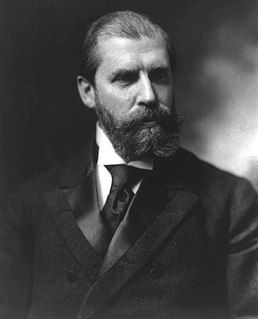
The 1908 New York state election was held on November 3, 1908, to elect the Governor, the Lieutenant Governor, the Secretary of State, the State Comptroller, the Attorney General, the State Treasurer, the State Engineer and a judge of the New York Court of Appeals, as well as all members of the New York State Assembly and the New York State Senate.

The 1906 New York state election was held on November 6, 1906, to elect the Governor, the Lieutenant Governor, the Secretary of State, the State Comptroller, the Attorney General, the State Treasurer and the State Engineer, as well as all members of the New York State Assembly and the New York State Senate.

The 1902 New York state election was held on November 4, 1902, to elect the Governor, the Lieutenant Governor, the Secretary of State, the State Comptroller, the Attorney General, the State Treasurer, the State Engineer and a judge of the New York Court of Appeals, as well as all members of the New York State Assembly and the New York State Senate.

The 1900 New York state election was held on November 6, 1900, to elect the Governor, the Lieutenant Governor, the Secretary of State, the State Comptroller, the Attorney General, the State Treasurer and the State Engineer, as well as all members of the New York State Assembly and the New York State Senate.

The 1894 New York state election was held on November 6, 1894, to elect the Governor, the Lieutenant Governor and a judge of the New York Court of Appeals, as well as all members of the New York State Assembly. Besides, a new State Constitution and four other constitutional amendments were proposed to the electorate, and were all accepted. Furthermore, the inhabitants of New York County and adjacent communities were asked if they wanted to join the proposed enlarged New York City, a project known as The Consolidation.

The 1898 New York state election was held on November 8, 1898, to elect the Governor, the Lieutenant Governor, the Secretary of State, the State Comptroller, the Attorney General, the State Treasurer and the State Engineer, as well as all members of the New York State Assembly and the New York State Senate.

The 1896 New York state election was held on November 3, 1896, to elect the Governor, the Lieutenant Governor and a judge of the New York Court of Appeals, as well as all members of the New York State Assembly. Besides, a constitutional amendment on forestry was proposed, and rejected with 321,486 votes for and 710,505 against it.

The 1932 New York state election was held on November 8, 1932, to elect the Governor, the Lieutenant Governor, the State Comptroller, the Attorney General, the Chief Judge, a U.S. Senator and two U.S. Representatives-at-large, as well as all members of the New York State Assembly and the New York State Senate.

The 1887 New York state election was held on November 8, 1887, to elect the Secretary of State, the State Comptroller, the Attorney General, the State Treasurer and the State Engineer, as well as all members of the New York State Assembly and the New York State Senate.

The 1889 New York state election was held on November 5, 1889, to elect the Secretary of State, the State Comptroller, the Attorney General, the State Treasurer, the State Engineer and a judge of the New York Court of Appeals, as well as all members of the New York State Assembly and the New York State Senate.

The 1893 New York state election was held on November 7, 1893, to elect the Secretary of State, the State Comptroller, the Attorney General, the State Treasurer, the State Engineer and a judge of the New York Court of Appeals, as well as all members of the New York State Assembly and the New York State Senate, and delegates to the New York State Constitutional Convention of 1894.

The 1895 New York state election was held on November 5, 1895, to elect the Secretary of State, the State Comptroller, the Attorney General, the State Treasurer, the State Engineer and a judge of the New York Court of Appeals, as well as all members of the New York State Assembly and the New York State Senate. Besides, the voters were asked if they approved of the State's issuing bonds for $9,000,000.00 to spend on canal improvements, which the electorate answered in the affirmative.

